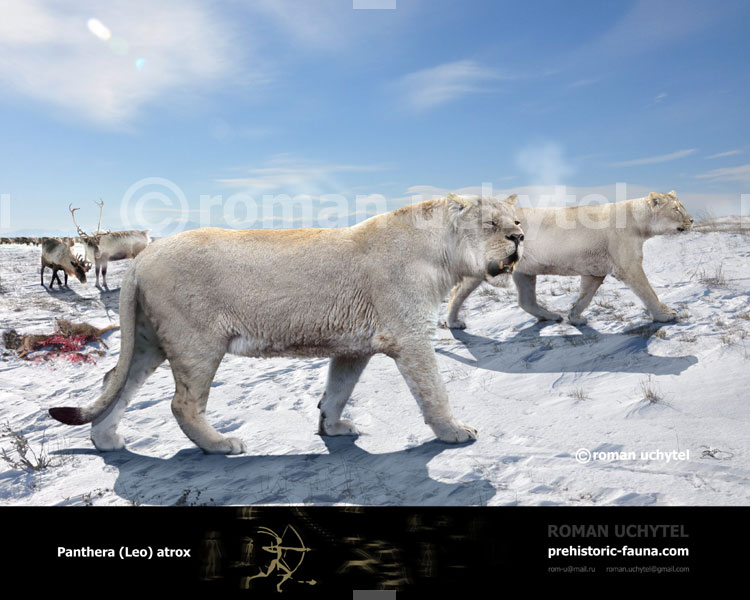Post by dinosauria101 on Mar 30, 2019 2:39:54 GMT 5
American Lion (coalition of 2) - Panthera leo atrox
The American lion (Panthera leo atrox or P. atrox) — also known as the North American lion, Naegele’s giant jaguar or American cave lion — is an extinct lion of the family Felidae, endemic to North America during the Pleistocene epoch (0.34 mya to 11,000 years ago), existing for approximately 0.33 million years. It has been shown by genetic analysis to be a sister lineage to the Eurasian cave lion (Panthera leo spelaea or P. spelaea). The American lion is an extinct animal which originated in North America and went on to colonize part of South America as part of the Great American Interchange. The head-body length of the American lion is estimated to have been 1.6–2.5 m (5 ft 3 in–8 ft 2 in) and it would have stood 1.2 metres (4 ft) at the shoulder. Thus it was smaller than its contemporary competitor for prey, the giant short-faced bear, which was the largest carnivoran of North America at the time. The American lion was not as heavily built as the saber-toothed cat Smilodon populator, which may have weighed up to 360–470 kilograms (790–1,000 lb). Sorkin (2008) estimated it to weigh roughly 420 kilograms (930 lb), but new estimations show a top weight of 351 kg (774lbs.) for the largest specimen and an average weight for males of 255.65 kg (563lbs.).

Giant (Long-horned) Bison - Bison latifrons
Bison latifrons is an extinct species of bison that lived in North America during the Pleistocene. Also known as the giant bison, it reached a shoulder height of 2.5 metres (8.5 feet), and had horns that spanned over 2 metres (6.5 feet). The known dimensions of the species are much larger than either extant species of bison (it was approximately twice the body size) and other extant large bovids, and B. latifrons may be the largest bovid in the fossil record. B. latifrons reached a shoulder height of 2.5 meters (8.2 ft) and weighed over 2,000 kilograms (4,400 lb).

Credit to Wikipedia
The American lion (Panthera leo atrox or P. atrox) — also known as the North American lion, Naegele’s giant jaguar or American cave lion — is an extinct lion of the family Felidae, endemic to North America during the Pleistocene epoch (0.34 mya to 11,000 years ago), existing for approximately 0.33 million years. It has been shown by genetic analysis to be a sister lineage to the Eurasian cave lion (Panthera leo spelaea or P. spelaea). The American lion is an extinct animal which originated in North America and went on to colonize part of South America as part of the Great American Interchange. The head-body length of the American lion is estimated to have been 1.6–2.5 m (5 ft 3 in–8 ft 2 in) and it would have stood 1.2 metres (4 ft) at the shoulder. Thus it was smaller than its contemporary competitor for prey, the giant short-faced bear, which was the largest carnivoran of North America at the time. The American lion was not as heavily built as the saber-toothed cat Smilodon populator, which may have weighed up to 360–470 kilograms (790–1,000 lb). Sorkin (2008) estimated it to weigh roughly 420 kilograms (930 lb), but new estimations show a top weight of 351 kg (774lbs.) for the largest specimen and an average weight for males of 255.65 kg (563lbs.).

Giant (Long-horned) Bison - Bison latifrons
Bison latifrons is an extinct species of bison that lived in North America during the Pleistocene. Also known as the giant bison, it reached a shoulder height of 2.5 metres (8.5 feet), and had horns that spanned over 2 metres (6.5 feet). The known dimensions of the species are much larger than either extant species of bison (it was approximately twice the body size) and other extant large bovids, and B. latifrons may be the largest bovid in the fossil record. B. latifrons reached a shoulder height of 2.5 meters (8.2 ft) and weighed over 2,000 kilograms (4,400 lb).

Credit to Wikipedia





